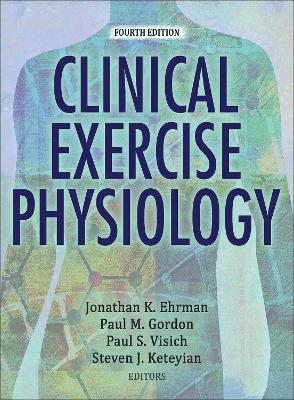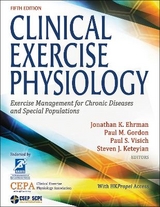
Clinical Exercise Physiology
Human Kinetics (Verlag)
978-1-4925-4645-0 (ISBN)
- Titel erscheint in neuer Auflage
- Artikel merken
As the profession of clinical exercise physiology continues to evolve, there is one cornerstone text that evolves along with it. Clinical Exercise Physiology, Fourth Edition With Web Resource, has been a mainstay in the field since its inception in 2003, and the revisions and additions to this latest rendition reinforce its elite status.
As the most comprehensive resource available, Clinical Exercise Physiology, Fourth Edition, provides greater coverage and depth of diseases than is typically found in most clinical exercise physiology textbooks. It thoroughly examines the effects of exercise on chronic disease and then investigates 24 chronic conditions, covering the scope of each disease as well as the pathophysiology, medications, and clinical applications. It also examines clinical considerations and exercise prescriptions for four special populations.
This fourth edition reflects the latest American College of Sports Medicine (ACSM) standards and guidelines, making it an ideal resource for candidates preparing for ACSM Clinical Exercise Physiologist certification. In addition to updated content that aligns with current science and evidence-based practice guidelines, the fourth edition also incorporates the following:
• A closer and more up-to-date look at the state of the profession
• A new web resource featuring case studies that depict real-life scenarios
• A new chapter on Parkinson’s disease
• Enhanced coverage of exercise testing and exercise prescription, in separate chapters to delve deeper into each of those topics
• An expanded chapter on end-stage renal disease, to more broadly cover chronic kidney disease
• Significant revisions to chapters on metabolic syndrome, diabetes, and heart failure
The online case studies are written in the form of SOAP (Subjective, Objective, Assessment, Plan) notes, reflecting common medical chart documentation, to help readers experience realistic examples. The text also offers Practical Application sidebars in each chapter; some of these sidebars focus on exercise prescription, and other Practical Application sidebars review the relevant literature related to physiological adaptations to exercise training. To aid in course preparation, instructors are provided a test package, chapter quizzes, and a presentation package plus image bank.
Clinical Exercise Physiology, Fourth Edition, offers a contemporary review of the variety of diseases and conditions that students and professionals may encounter in the field. New and veteran clinical exercise physiologists alike, as well as those preparing for ACSM certification exams, will appreciate the in-depth coverage of the clinical populations that benefit from physical activity and exercise.
Jonathan K. Ehrman, PhD, FACSM, is the associate program director of preventive cardiology and director of the weight management program at Henry Ford Hospital in Detroit. He has a 33-year background in clinical exercise physiology and is certified by ACSM as aclinical exercise physiologist and as a program director. He previously served as the chair of the clinical exercise physiologist credentialing committee for ACSM. Dr. Ehrman is author of more than 200 manuscripts and abstracts as well as several text books and chapters. He is an associate editor of the most recent edition (10th) of ACSM’s Guidelines for Exercise Testing and Prescription. He was also the senior editor of the sixth edition of ACSM's Resource Manual for Guidelines for Exercise Testing and Prescription. He is a fellow of the American College of Sports Medicine and the American Association of Cardiovascular and Pulmonary Rehabilitation and a member the American Heart Association and the American College of Cardiology. Dr. Ehrman earned his PhD in clinical exercise physiology from The Ohio State University. Paul M. Gordon, PhD, MPH, FACSM, is a professor and chair of the department of health, human performance, and recreation at Baylor University. He is certified by the ACSM as a clinical exercise physiologist and has over 20 years of experience teaching clinical exercise physiology curricula and directing cardiopulmonary rehabilitation programs. Dr. Gordon has published more than 200 papers and abstracts and several chapters, including in ACSM’s Guidelines for Exercise Testing and Prescription. He has also served as an examiner and coordinator for ACSM certification and credentialing. Dr. Gordon is a fellow of the American College of Sports Medicine, the Obesity Society, and the Centers for Disease Control Physical Activity Research Program. He is an international member of the Royal Society for Medicine. He earned his PhD in exercise physiology and an MPH in epidemiology from the University of Pittsburgh. Paul S. Visich, PhD, MPH, has nearly 20 years of experience in clinical exercise physiology and is the director of the Human Performance Laboratory in the College of Health Professions at Central Michigan University. He worked for 12 years in a clinical setting that included cardiac and pulmonary rehabilitation and primary disease prevention. His research interests involve the assessment of cardiovascular disease risk factors in children, the influence of resistance training in elderly populations, and altitude physiology. Dr. Visich is a member of ACSM’s exercise physiology credentialing committee and previous chair of their professional education committee. He is the author of more than 70 published scientific articles and abstracts. He earned a PhD in exercise physiology and an MPH in epidemiology from the University of Pittsburgh. Steven J. Keteyian, PhD, FACSM, has more than 35 years of experience working as a clinical exercise physiologist. He is program director of preventive cardiology at the Henry Ford Hospital in Detroit. Over the course of his career, Dr. Keteyian has focused on exercise and physical activity in both healthy individuals and those with chronic diseases. He is the author of more than 100 scientific articles and book chapters as well as four textbooks. Dr. Keteyian is a member of the American Associatioon of Cardiovascular and Pulmonary Rehabilitation and the American Heart Association. He is a fellow of the American College of Sports Medicine. He earned his PhD from Wayne State University in Detroit.
Part I. Introduction to Clinical Exercise Physiology
Chapter 1. The Profession of Clinical Exercise Physiology
Jonathan K. Ehrman, PhD, Paul M. Gordon, PhD, MPH, Paul S. Visich, PhD, MPH, and Steven J. Keteyian, PhD
The Past, Present, and Future of Clinical Exercise Physiology
Professional Organizations and Certifications Throughout the World
Professionalization of Clinical Exercise Physiology
Conclusion
Chapter 2. Promoting a Physically Active Lifestyle
Gregory W. Heath, DHSc, MPH, and Josh M. Johann, MS
Benefits of Physical Activity
Participation in Regular Physical Activity
Conclusion
Chapter 3. General Principles of Pharmacology
Steven J. Keteyian, PhD
General Properties of Drugs
Routes of Administration
Phases of Drug Effect
Mechanism of Action
Pharmacotherapy
Conclusion
Chapter 4. General Interview and Examination Skills
Quinn R. Pack, MD, MSc, FACC, and Hayden Riley, MS
General Interview
Physical Examination
Conclusion
Chapter 5. Graded Exercise Testing
Steven J. Keteyian, PhD, and Micah Zuhl, PhD
Indications
Contraindications
Procedures for Preparing, Conducting, and Interpreting a Graded Exercise Test
Graded Exercise Testing With Diagnostic Imaging
Conclusion
Chapter 6. Exercise Prescription
Steven J. Keteyian, PhD
Exercise Training Sequence
Goal Setting
Principles of Exercise Prescription
Cardiorespiratory Endurance
Skeletal Muscle Strength and Endurance
Flexibility Training
Conclusion
Part II. Endocrinology and Metabolic Disorders
Chapter 7. Diabetes
Sheri R. Colberg, PhD, FACSM
Definition
Scope
Pathophysiology
Clinical Considerations
Exercise Prescription
Exercise Training
Conclusion
Chapter 8. Obesity
David C. Murdy, MD, and Jonathan K. Ehrman, PhD, FACSM, FAACVPR, ACSM-CEP
Definition
Scope
Pathophysiology
Clinical Considerations
Exercise Prescription
Exercise Training
Conclusion
Chapter 9. Hypertension
Amanda L. Zaleski, MS, Antonio B. Fernandez, MD, Beth A. Taylor, PhD, and Linda S. Pescatello, PhD, FACSM, FAHA
Definition
Scope
Pathophysiology
Clinical Considerations
Exercise Prescription
Exercise Training
Conclusion
Chapter 10. Hyperlipidemia and Dyslipidemia
Peter W. Grandjean, PhD, FACSM, ACSM–CEP, EIM3, Stephen F. Crouse, PhD, FACSM, J. Larry Durstine, PhD, FACSM, FAACVPR, Paul G. Davis, PhD, FACSM, RCEP, and Benjamin Gordon, PhD, RCEP
Definition
Scope
Pathophysiology
Clinical Considerations
Exercise Prescription
Exercise Training
Conclusion
Chapter 11. Metabolic Syndrome
Mark D. Peterson, PhD, MS, Paul M. Gordon, PhD, MPH, and Flor Elisa Morales, MS
Definition
Scope
Pathophysiology
Clinical Considerations
Exercise Prescription
Exercise Training
Conclusion
Chapter 12. Chronic Kidney Disease
Samuel Headley, PhD, Sahil Bawa, MBBS, and Michael Germain, MD
Definition
Scope
Pathophysiology
Clinical Considerations
Exercise Prescription
Exercise Training
Conclusion
Part III. Cardiovascular Diseases
Chapter 13. Acute Coronary Syndromes: Unstable Angina Pectoris and Acute Myocardial Infarction
Ray W. Squires, PhD, MAACVPR, FACSM, FAHA
Pathophysiology
Clinical Assessment
Exercise Training: Inpatient Cardiac Rehabilitation
Exercise Training: Early Outpatient Cardiac Rehabilitation
Exercise Prescription
Conclusion
Chapter 14. Revascularization of the Heart
Neil A. Smart, PhD
Definition
Scope
Pathophysiology
Clinical Considerations
Exercise Prescription and Training
Conclusion
Chapter 15. Chronic Heart Failure
Steven J. Keteyian, PhD
Definition
Scope
Pathophysiology
Clinical Considerations
Exercise Prescription
Exercise Training
Conclusion
Chapter 16. Peripheral Artery Disease
Ryan J. Mays, PhD, MPH, MS, Ivan P. Casserly, MB, BCh, and Judith G. Regensteiner, PhD
Definition
Scope
Pathophysiology
Clinical Considerations
Exercise Prescription
Exercise Training
Conclusion
Chapter 17. Cardiac Electrical Pathophysiology
Kerry J. Stewart, EdD, and David D. Spragg, MD
Definition
Scope
Pathophysiology
Clinical Considerations
Exercise Prescription and Training
Conclusion
Part IV. Diseases of the Respiratory System
Chapter 18. Chronic Obstructive Pulmonary Disease
Satvir S. Dhillon, MSc, Dennis Jensen, PhD, and Jordan A. Guenette, PhD
Definition
Scope
Pathophysiology
Clinical Considerations
Exercise Prescription
Exercise Training
Conclusion
Chapter 19. Asthma
Brian W. Carlin, MD
Definition
Scope
Pathophysiology
Clinical Considerations
Exercise Prescription
Exercise Training
Conclusion
Chapter 20. Cystic Fibrosis
Michael J. Danduran, MS, and Lauren Camarda, MD
Definition
Scope
Pathophysiology
Clinical Considerations
Exercise Prescription
Exercise Training
Conclusion
Part V. The Immune System
Chapter 21. Cancer
Dennis J. Kerrigan, PhD, John R. Schairer, DO, and Kerry S. Courneya, PhD
Definition
Scope
Pathophysiology
Clinical Considerations
Exercise Prescription
Exercise Training
Conclusion
Chapter 22. Human Immunodeficiency Virus
Mansueto Neto, PhD
Definition
Scope
Pathophysiology
Clinical Considerations
Exercise Prescription
Exercise Training
Conclusion
Part VI. Disorders of the Bones and the Joints
Chapter 23. Arthritis
Andrew B. Lemmey, PhD
Definition
Scope
Pathophysiology
Clinical Considerations
Exercise Prescription
Exercise Training
Conclusion
Chapter 24. Osteoporosis
Lora M. Giangregorio, PhD
Definition
Scope
Pathophysiology
Clinical Considerations
Exercise Prescription
Exercise Training
Conclusion
Chapter 25. Nonspecific Low Back Pain
Jan Perkins, PT, PhD, and J. Tim Zipple, PT, DSc
Definition
Scope
Pathophysiology
Clinical Considerations
Exercise Prescription and Training
Conclusion
Part VII. Neuromuscular Disorders
Chapter 26. Spinal Cord Injury
Mary P. Galea, PhD, L. Eduardo Cofré Lizama, PhD, and Andisheh Bastani, PhD
Definition
Scope
Pathophysiology
Clinical Considerations
Exercise Prescription
Exercise Training
Conclusion
Chapter 27. Multiple Sclerosis
Linda H. Chung, PhD
Definition
Scope
Pathophysiology
Clinical Considerations
Exercise Prescription
Exercise Training
Conclusion
Chapter 28. Cerebral Palsy
Désirée B. Maltais, PT, PhD
Definition
Scope
Pathophysiology
Clinical Considerations
Exercise Prescription
Exercise Training
Conclusion
Chapter 29. Stroke
Christopher J. Womack, PhD
Definition
Scope
Pathophysiology
Clinical Considerations
Exercise Prescription
Exercise Training
Conclusion
Chapter 30. Parkinson’s Disease
Angela L. Ridgel, PhD, and Brandon S. Pollock, PhD
Definition
Scope
Pathophysiology
Clinical Considerations
Exercise Prescription
Exercise Training
Conclusion
Part VIII. Special Populations
Chapter 31. Children
Timothy J. Michael, PhD, and William A. Saltarelli, PhD
Definition
Scope
Clinical Considerations
Exercise Prescription
Exercise Training
Conclusion
Chapter 32. Aging
Jerome L. Fleg, MD, and Daniel E. Forman, MD
Definition
Scope
Pathophysiology
Clinical Considerations
Exercise Prescription and Training
Conclusion
Chapter 33. Depression
Benson M. Hoffman, PhD, Krista A. Barbour, PhD, and James A. Blumenthal, PhD
Definition
Scope
Pathophysiology
Clinical Considerations
Exercise Prescription and Training
Conclusion
Chapter 34. Intellectual Disability
Bo Fernhall, PhD, and Tracy Baynard, PhD
Definition
Scope
Pathophysiology
Clinical Considerations
Exercise Prescription
Exercise Training
Conclusion
| Erscheinungsdatum | 18.09.2018 |
|---|---|
| Verlagsort | Champaign, IL |
| Sprache | englisch |
| Gewicht | 1996 g |
| Themenwelt | Medizin / Pharmazie ► Physiotherapie / Ergotherapie ► Rehabilitation |
| Studium ► 1. Studienabschnitt (Vorklinik) ► Physiologie | |
| Naturwissenschaften ► Biologie ► Humanbiologie | |
| ISBN-10 | 1-4925-4645-3 / 1492546453 |
| ISBN-13 | 978-1-4925-4645-0 / 9781492546450 |
| Zustand | Neuware |
| Informationen gemäß Produktsicherheitsverordnung (GPSR) | |
| Haben Sie eine Frage zum Produkt? |
aus dem Bereich



